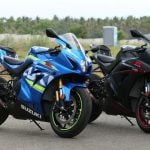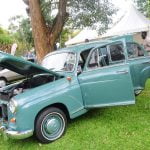
A few good things have come from this era of hipster revolution, thinks Sherman Nazareth, astride the retro-styled Desert Sled. Has Ducati’s Scrambler finally earned its true off-road stripes?

Located in the South of Spain, the quaint little town of Almeria sits on the shores of the Mediterranean Sea and boasts of perfect weather for the most part of the year. Unfortunately, this wasn’t one of those times. We were greeted by damp conditions that saw the mercury hover around the 10deg mark. Bearable, if you’re padded up and walking around, but not so much when you’re on a motorcycle and there’s rain and ice-cold wind lashing at your face. Nonetheless, we are here to test the Desert Sled, a version of the Scrambler that Ducati claims is finally off-road worthy.
Cut to a scene in the Tabernas Desert, just on the outskirts of Almeria. This is a Western-themed film set on which The Good, the Bad and the Ugly was shot. And it really does take you back to the American frontier – to a time of rowdy cowboys and tobacco-filled spittoons. No horses around though, just a whole line of Ducati Desert Sleds. With a lineage that dates back to the 1960s and a name that modified street motorcycles got for their ability to race across treacherous passes in the North American deserts, the Desert Sled has some big shoes to fill. And, at first glance, it certainly seems to look the part.

Parlour tricks
By now we’re all quite familiar with the Scrambler look; retro is certainly in. The Desert Sled has roughly the same basic silhouette as the base Scrambler, but there’s more, just so much more. For starters, it’s a lot taller now, but quite deceptive, as it looks like the smaller street-oriented Scramblers from afar. On the surface, it’s got a nice raised front mud guard and a more upright handlebar, but it’s beneath the surface where all the real magic has taken place.

The chassis has been beefed up to handle the extra torsional forces that come during dirt riding. There’s an extra piece of tubing on the lateral edges of the frame that help with chassis stiffness. It also gets new side plates at the swingarm pivot junction that’ll help take some engine load off the frame. The new swingarm is reinforced and longer than the one on base Scramblers. While up front the Desert Sled gets updated triple clamps and widened inter-fork clearance. All this has been done to increase overall stiffness, to ensure that this bike will still be standing, no matter what you throw at it. In fact, this version of the Scrambler has definitely been designed with airborne shenanigans in mind.

Ducati has equipped the Desert Sled with a fully adjustable 46mm Kayaba fork at the front, and a rebound/preload-adjustable Kayaba shock at the rear; quite a big jump from the base Scrambler that gets 41mm Kayaba forks. Both ends have a whole 200mm of travel, which is more than what some of the larger adventure bikes have. It’s also equipped with 19-inch front and 17-inch rear spoked wheels that are shod with dual-purpose Pirelli Scorpion Rally STR tyres. And boy, are these tyres great! Even in damp conditions on the street they provided more than sufficient grip and performed surprisingly well, with none of the squirm that comes from knobbly tyres. Obviously, on the dirt, they were just excellent. These tyres share a 50/50 on-road, off-road bias.

The only thing that has remained relatively unchanged, aside from the body panels, is Ducati’s Desmodue 803cc L-twin engine which was only updated to meet Euro-IV emissions standards. Thankfully, though, the bike hasn’t lost any power in that update. The Desert Sled produces 73hp and 67Nm of torque. It also gets a ride-by-wire throttle now, which has certainly sorted out the throttle issue on the older models. The weight, however, has gone up to about 207kg, which is roughly 20kg more than the Scrambler Icon; this can also be attributed to the heavier hardware needed to meet up to the new stricter emission norms.

Into the borderlands
Get into the saddle and, initially, it is a bit intimidating. Saddle height has gone up to 860mm, although there is a lower 840mm seat available as an accessory; still very tall for the average Indian frame. Once you get moving, the new seating posture is just brilliant; it’s an extremely natural position. On the street, the bike gives you a really commanding feel thanks to its tall stature. It doesn’t just ride well over bumps and undulations, it obliterates them. And that is perfect for holding a decently quick pace over any road in the country; you won’t have to stick to just highways with this one. Also, the engine feels smoother than before thanks to the ride-by-wire throttle. Throttle inputs are a bit watered down now and that keeps the bike from doing anything unexpected while in the corners.

But on the dirt is where this bike really shines. Standing ergonomics on the Desert Sled are again very natural; the handlebars are raised and wide, and you get a nice, comfortable lean into them thanks to the footpeg position. And the tank is just wide enough to grip well with your knees. Thanks to the rain spells during our test ride, the off-road course Ducati laid out for us had turned into a combination of soft slush, hard-packed gravel and wet sand. And for those of us who hadn’t spent too much time in the dirt, a really intimidating proposition. After switching off the ABS and a few minutes trudging through all this, those qualms were quashed; the Desert Sled was just phenomenal off-road. It held its composure so well that it really encouraged you to push it harder. In no time, I was giving it the gas while coming out of corners and allowing the rear to step out.

Flying over ruts and locking up the rear wheel is just so easy here. In fact, it handles the rough stuff better than most larger displacement adventure bikes, and that’s because it’s more of an actual big dirt bike than a pseudo off-roading one. There’s no big fairing up front to hamper your vision or break when you fall over (expected when you’re riding in the dirt). Instead, you get a bash plate as standard and you can get engine guards which are available as accessories. Off-roading is just so much easier than it should be on the Sled, and the only issue I seemed to find with the bike is the engine heat. While the heat was a relief in the cold, damp weather of the Tabernas, it’s going to be quite a pain here in India.

Freedom Express
Everything else is typical Ducati Scrambler, and fit and finish is solid. The bike simply sounds, looks, and feels great. It has exceeded expectations in almost every department. For all you big bike adventure enthusiasts out there, you might want to seriously consider the Desert Sled before you put your money down on some bulky larger-displacement adventure bike. The only argument, of course, is that it might be a bit expensive. The price tag of Rs 9.32lakh, which is kind of justified, considering the quality of components the bike is fitted with. But, that being said, I’ve been considering picking one up myself, given I can locate a few spare organs I won’t be needing. Maybe it’s the fantasy of riding through the unbridled, Wild West, or maybe it’s the fact that this bike could go almost anywhere an actual enduro bike could.
[“Source-autocarindia”]





